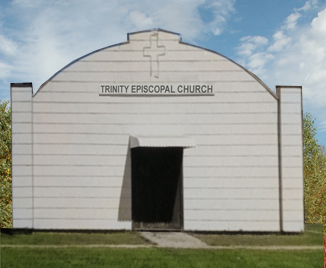|
|
|
At the time of the breaking out of the Civil War there was a small religious organization in Winterset known as St. James Parish of the Protestant Episcopal Church. The organization soon passed out of existence. The present (1879) church was organized in 1876 with the following original members of the Mission: Mrs. C. B. Welch, Mrs. H. C. Winchester, Dr. F. A. Hall and wife, C. W. Hale and family, Mrs. Andrew Crawford and William Lowe. The present building is a cozy , neat little frame building and was erected in 1878 at a cost of $700. Rev. J. A. Stoddard is the missionary pastor and the membership of the church is twenty-two1.
In 1881 and 1882, Rev. R. W. Estabrook2 was the regularly installed pastor. It is our impression that he was the only resident pastor that the church has ever had. |
Trinity Episcopal Church (as of May 1, 1964) Photo courtesy of Madison County Historical Society
|
||||||||||
|
C. W. Hale and family, Mrs. C. B. Welch, Mrs. Winchester, and Mrs. A. Crawford have been the leading members of the church in time past. Of these, Mrs. Hale and her daughter, Hattie, alone remain. Others have come here to reside in the meantime and services are occasionally held.3
The original chapel stood on 420 East Court Street on the northwest corner of the lot. This land was given for the church by Mrs. Winchester, a devout Episcopalian with the provision that the land revert to her estate after one year, if the land should no longer be used for the church. Two years after the Episcopal Church got started here, Judge P. R. Wilkinson, a retired judge and a native of Winterset, was baptized in the Trinity Chapel in 1878 at the age of a few months and later was confirmed there. In his adult years he served as a warden for a time. At that time, Dr. Esterbrook of Des Moines was rector, but many services were conducted by a lay reader, a bank cashier name Mr. Hale. There was a good sized congregation, a good organ and ample communion service at that time.
Dr. Esterbrook was succeeded as rector by Rev. Mr. Judd of Des Moines, and he was succeeded by Rev. Thomas Cassidy of St. Paul’s Episcopal Church in Des Moines, who later became Bishop of Oklahoma. A depot agent, Mr. Griffen, was his lay reader.
In 1930, the church was dismantled, and the altar appointments were sent to a Negro church in the South by the Bishop Longley, and the building itself was sold and moved to 202 South 2nd Street, where it now stands in use as a private home.
The church was dormant until about 1946 when the church was reactivated Services were begun in the home of Mrs. Harvey Paull, and the Rev. Paul J. Davis, now secretary of the Iowa Dioceses, hitch-hiked from Creston to Winterset on Sunday afternoon for 3 pm. Services. A Sunday School was started about this time with two teachers, Mrs. Harvey Paull, and Mrs. Donald Graves. Instruction was held in the homes of the teachers until 1956, when the children were driven to St. Andrew’s Episcopal Church in Des Moines for Sunday School.
From 1950-55 services were held intermittently, usually once a month, at St. Paul’s Lutheran Church in Winterset. The congregation was served during this time by Father Paul Davis, Father Theodore Schneider, a Captain St. Andrew, and Father Robert Kem, coming either from Des Moines or Creston for services.
No established church was recognized by the diocese from July 1955 until November 1961, but the congregation stayed together and was active locally, participating with other churches in union services, and meeting together privately on occasion Occasionally, services were attended at St. Andrew’s church in Des Moines.
In December of 1961 the congregation began organizing again. Father Clark Trafton of Creston was appointed by Bishop Gordon Smith to be the rector. Lewis Jordan and Warren West became licensed lay readers. Services were held weekly at 4 p.m. in the living room of Gordon Risher, a local lawyer. The congregation made the altar and kneeling benches, the altar linens, etc. On February 11, 1962, services moved to the VFW Hall and were held again in the afternoon, weekly, until September 16, 1962. During this time Father Trafton came once a month for Communion and the other services were conducted by lay readers.
In September of 1962 services were moved to St. Paul’s Lutheran Church, where they had been held years before, and continued there until May 1, 1964, when they were moved finally to the present location on East Washington Street. The building is owned by the Four Square Gospel Church but has been used by the Episcopalians since the Four Square Gospel Church purchased another building.
In July of 1965, Father Trafton left to become a postulant of a Holy Order for Episcopal men, The Order of the Holy Cross in West Park, New York, and the Rev. Michael Link, of Creston, became the present rector. The inside of the building has been furnished mostly by individual church men and women. A piano provides the accompaniment for singing. There is no choir. Membership numbers twelve adults and three children and shows promise of growing.4 __________________
|
|||||||||||
| Maintained by the County Coordinator |
This
page was created on February 6, 2023. This page was last updated Tuesday, 04-Apr-2023 16:12:05 CDT . |



